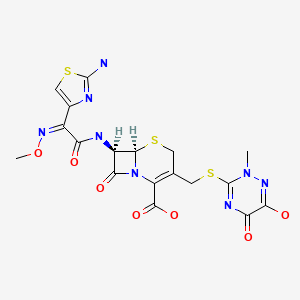Attribution Statement: LactMed is a registered trademark of the U.S. Department of Health and Human Services.
NCBI Bookshelf. A service of the National Library of Medicine, National Institutes of Health.
Drugs and Lactation Database (LactMed®) [Internet]. Bethesda (MD): National Institute of Child Health and Human Development; 2006-.
CASRN: 73384-59-5

Drug Levels and Effects
Summary of Use during Lactation
Limited information indicates that ceftriaxone produce low levels in milk, which are not expected to cause adverse effects in breastfed infants. Occasionally disruption of the infant's gastrointestinal flora, resulting in diarrhea or thrush have been reported with cephalosporins, but these effects have not been adequately evaluated. Ceftriaxone is acceptable in nursing mothers.
Drug Levels
Maternal Levels. Following administration of a 1 gram dose of ceftriaxone intramuscularly or intravenously on day 3 postpartum to 20 women, peak milk levels averaged about 0.7 and 0.5 mg/L, respectively.[1] Peaks occurred about 4 hours after the dose and fell very slowly over 24 hours with half-lives of 13 to 17 hours. The amounts in milk represent an infant dosage of about 0.5% of the maternal weight-adjusted dosage. The infant would be expected to ingest only a few milligrams of ceftriaxone per day with usual doses.
Infant Levels. Relevant published information was not found as of the revision date.
Effects in Breastfed Infants
A mother who was exclusively nursing her 52-day-old infant developed a soft-tissue infection. She was treated with intravenous teicoplanin 400 mg every 12 hours for 3 doses, then 400 mg daily for 5 days total, intravenous ceftriaxone 1 gram daily, topical mupirocin cream twice daily. A careful follow-up indicated that her infant had no adverse effects.[2]
Effects on Lactation and Breastmilk
Relevant published information was not found as of the revision date.
References
- 1.
- Kafetzis DA, Brater DC, Fanourgakis JE, et al. Ceftriaxone distribution between maternal blood and fetal blood and tissues at parturition and between blood and milk postpartum. Antimicrob Agents Chemother. 1983;23:870–3. [PMC free article: PMC184988] [PubMed: 6311089]
- 2.
- Kaplan YC, Keskin-Arslan E, Acar S et al. Teicoplanin use during breastfeeding. Breastfeed Med. 2017.. [PubMed: 28051878]
Substance Identification
Substance Name
Ceftriaxone
CAS Registry Number
73384-59-5
Drug Class
Breast Feeding
Lactation
Anti-Infective Agents
Antibacterial Agents
Cephalosporins
Disclaimer: Information presented in this database is not meant as a substitute for professional judgment. You should consult your healthcare provider for breastfeeding advice related to your particular situation. The U.S. government does not warrant or assume any liability or responsibility for the accuracy or completeness of the information on this Site.
- User and Medical Advice Disclaimer
- Drugs and Lactation Database (LactMed) - Record Format
- LactMed - Database Creation and Peer Review Process
- Fact Sheet. Drugs and Lactation Database (LactMed)
- Drugs and Lactation Database (LactMed) - Glossary
- LactMed Selected References
- Drugs and Lactation Database (LactMed) - About Dietary Supplements
- Breastfeeding Links
- PMCPubMed Central citations
- PubChem SubstanceRelated PubChem Substances
- PubMedLinks to PubMed
- Review Ceftizoxime.[Drugs and Lactation Database (...]Review Ceftizoxime.. Drugs and Lactation Database (LactMed®). 2006
- Review Cefotaxime.[Drugs and Lactation Database (...]Review Cefotaxime.. Drugs and Lactation Database (LactMed®). 2006
- Review Cefditoren.[Drugs and Lactation Database (...]Review Cefditoren.. Drugs and Lactation Database (LactMed®). 2006
- Review Cefixime.[Drugs and Lactation Database (...]Review Cefixime.. Drugs and Lactation Database (LactMed®). 2006
- Review Cefazolin.[Drugs and Lactation Database (...]Review Cefazolin.. Drugs and Lactation Database (LactMed®). 2006
- Ceftriaxone - Drugs and Lactation Database (LactMed®)Ceftriaxone - Drugs and Lactation Database (LactMed®)
Your browsing activity is empty.
Activity recording is turned off.
See more...
